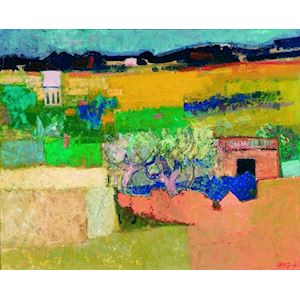
20. Wim Oepts - Landscape, South of France, 1971
This painting of a French landscape was created by Wim Oepts. It is composed of coloured areas like patchwork, painted next to – and partly over – each other. You can see that the layers of the bottom often shimmer through the top layer. To strengthen this effect, he treated the paint with his palette knife or on the reverse side of his pencil. “A surface must vibrate,” according to Oepts. As we were curious about this lower layer, four of Oept's paintings were examined using special photographic technology. The base of the painting gives us a better understanding of how he worked. Eventually, under the originals, many other paintings were found. Oepts left some layers in the final result, while he painted over others so that they disappeared under a new layer. Wim Oepts said about his work methods “I try to immediately sketch the pattern. If I am drawing I am spontaneous. Things that are not important, I leave out. What remains, I try to translate into colour.” In addition to clear colours, Oepts used black with accents of brown, blue or green to highlight other colours. Due to this contrast, his choice of colours is intensified. Wim Oepts painted his landscapes in his Paris studio from studies and photos he made in the Summer in the south of France. The southern French landscape was an endless source of inspiration for him. He was inspired by the artists Paul Cezanne and Vincent van Gogh.


The Musea Zutphen -Stedelijk Museum Zutphen en het Museum Henriette Polak- are located in the 17th-century city palace Hof van Heeckeren. History, cultural history, visual arts and topical matters meet here in a surprising way
- 's Gravenhof 4
- Zutphen Netherlands
- 0575516878
- www.museazutphen.nl
